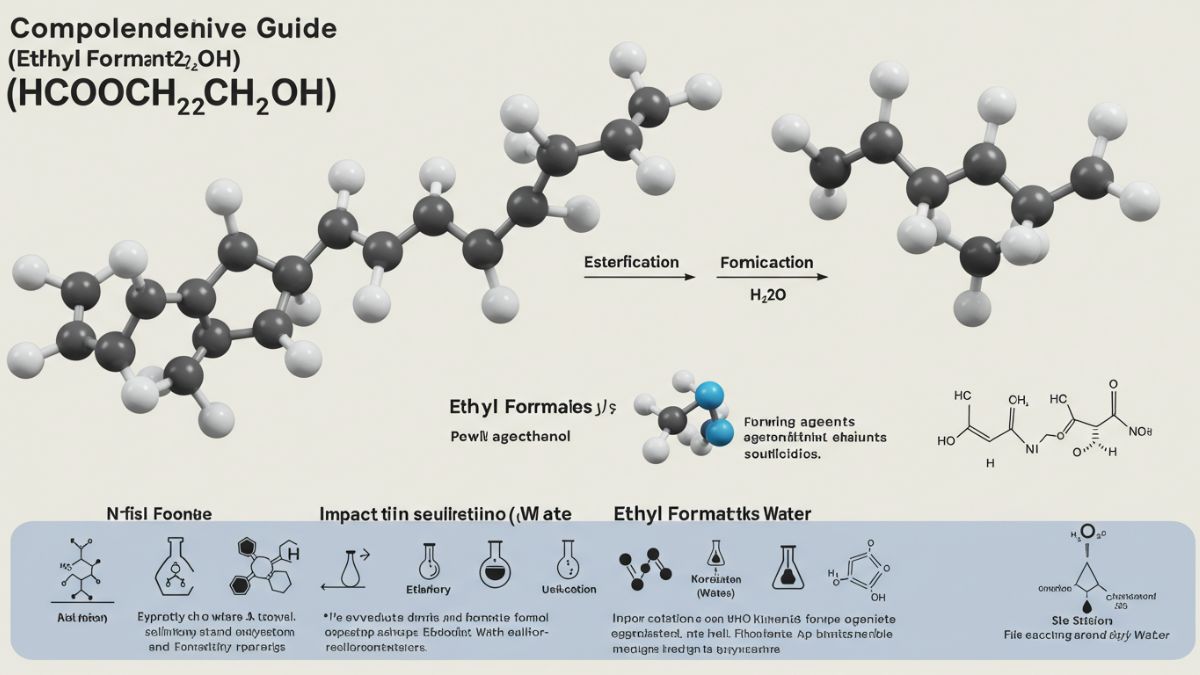Chemistry is full of fascinating compounds and reactions that shape the world around us. One such intriguing expression is HCOOCH CH2 H2O. Though it may look like a cluster of chemical symbols, this formula points to an interaction involving ester compounds, hydrocarbons, and water. In this guide, we’ll break down what hcooch ch2 h2os means, the reactions it can undergo, and how it is applied in the real world.
What Does HCOOCH CH2 H2Os Represent?
The combination HCOOCH CH2 H2O might appear abstract, but it reveals important clues when examined piece by piece:
-
HCOOCH suggests the presence of methyl formate, an ester derived from formic acid and methanol.
-
CH2 often refers to a methylene group, a common fragment in organic molecules.
-
H2O is water, a universal solvent and reactant in chemical processes.
Together, these parts suggest a chemical system involving ester hydrolysis or organic reactions involving water and carbon chains.
Structure and Chemical Interpretation
Let’s delve into the likely meaning behind this formulation:
Methyl Formate – HCOOCH3
The ester part, HCOOCH, most accurately stands for methyl formate (HCOOCH₃), a colorless, flammable liquid with a fruity odor. It is widely used as a solvent and intermediate in various chemical processes.
CH2 Group
The CH2 group indicates a methylene bridge, often found in alkenes or organic intermediates. In organic reactions, CH2 fragments are known to participate in bond formation and rearrangement.
H2O – Water
Water is critical in many organic transformations, particularly hydrolysis, where it breaks bonds in larger molecules like esters, splitting them into an acid and an alcohol.
Reactions Involving HCOOCH CH2 H2O
The components of hcooch ch2 h2o hint at a reaction scenario where an ester like methyl formate reacts with water and possibly a hydrocarbon segment involving CH2.
Ester Hydrolysis
A well-known process where esters react with water to form acids and alcohols. This reaction can be acid- or base-catalyzed.
Example Reaction:
This equation shows methyl formate breaking down into formic acid (HCOOH) and methanol (CH₃OH) when water is present.
Potential CH2 Interactions
The CH2 group might point to a reaction intermediate or side product. It could also suggest a molecule like ethene (CH2=CH2) or a linkage within a more complex compound.
Industrial Importance of HCOOCH CH2 H2O Reactions
Understanding reactions like those involving hcooch ch2 h2os is critical across many industries. Let’s look at where this knowledge applies.
1. Chemical Manufacturing
Reactions involving methyl formate and water are used to synthesize other chemicals. These include:
-
Formic acid, used in leather and rubber production.
-
Methanol, a base for formaldehyde and antifreeze production.
2. Pharmaceuticals
Ester hydrolysis reactions help create pharmaceutical intermediates. Formic acid derivatives and methanol play key roles in drug formulation and active ingredient production.
3. Agriculture
In agrochemical labs, methyl formate is used in pesticide synthesis. Reactions with water are controlled to ensure correct chemical balances for safe and effective formulations.
4. Flavor and Fragrance
Methyl formate is used in producing fruit-flavored esters. Its controlled reaction with water affects aroma stability and shelf life in commercial products.
Laboratory Role of HCOOCH CH2 H2Os
In the academic world, hcooch ch2 h2o serves as a valuable example of ester behavior in organic chemistry. Students observe:
-
Kinetics of ester hydrolysis.
-
Effects of catalysts (acids or bases).
-
pH shifts and equilibrium in aqueous solutions.
These reactions help illustrate core organic chemistry principles and train students in lab skills such as titration, refluxing, and chromatography.
Environmental Considerations
While methyl formate is biodegradable, the hydrolysis process and the resulting products must be monitored in environmental contexts.
-
Formic acid can alter water pH, affecting aquatic life.
-
Methanol is toxic in high concentrations.
Thus, the hcooch ch2 h2o pathway is important in environmental chemistry, particularly when examining pollutant breakdown or industrial runoff.
Mechanism of Ester Hydrolysis
To understand the chemistry better, here’s a simplified explanation of how ester hydrolysis works:
-
Nucleophilic attack: Water (H₂O) attacks the carbon in the ester group (HCOOCH₃).
-
Transition state: An unstable intermediate forms temporarily.
-
Bond cleavage: The ester bond breaks, forming formic acid and methanol.
Green Chemistry and Sustainability
Modern research looks to optimize the hcooch ch2 h2os process with sustainability in mind:
-
Using biocatalysts (enzymes) instead of harsh acids.
-
Reducing energy use by performing reactions at ambient temperature.
-
Recycling water and solvents to lower waste.
Such improvements are essential for making chemical production more eco-friendly.
Safety and Handling
When dealing with methyl formate and related reactions:
-
Use gloves and goggles.
-
Work in a ventilated area or fume hood.
-
Store chemicals in properly labeled containers.
-
Dispose of waste as per local hazardous material guidelines.
Even though the components in hcooch ch2 h2o reactions are relatively common, safety must always be a priority.
Conclusion
The expression hcooch ch2 h2o may seem complex at first, but it opens up a window into critical chemical processes, especially ester hydrolysis. Whether it’s in a lab experiment, industrial production, or academic discussion, this combination of compounds plays an essential role in understanding organic chemistry.
By analyzing its structure, reactions, and real-world relevance, we’ve explored how hcooch ch2 h2os connects theory and application. As the world leans further into sustainable chemistry, mastering these reactions remains as important as ever.
